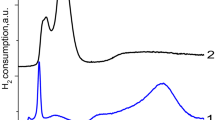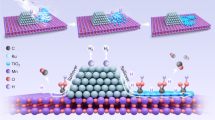Abstract
Steady-state and transient kinetic experiments were performed in a versatile microreactor flow set-up with magnesia- and alumina-supported ruthenium catalysts in order to elucidate the mechanism of the selective catalytic reduction (SCR) of nitric oxide with hydrogen. Both Ru/MgO and Ru/γ-Al2O3 were found to be highly active catalysts converting NO and H2 into N2 and H2O with selectivities close to 100% at full conversion, although Ru-based catalysts are known to be active in the synthesis of NH3 from N2 and H2. Frontal chromatography experiments with NO at room temperature revealed that NO and its dissociation products displace adsorbed atomic hydrogen (H−*) almost completely from hydrogen-precovered Ru surfaces. Obviously, NO and H2 compete for the same adsorption sites, H−* being the weaker bound adsorbate. Temperature-programmed surface reaction (TPSR) experiments in H2 subsequent to NO exposure demonstrated that higher heating rates and lower partial pressures of H2 shift the selectivity from NH3 to N2. Therefore, the coverage of H−* is concluded to govern the branching ratio between the rate of associative desorption of N2 (2N−*→N2 + 2*) and the rate of hydrogenation of N−* (N−* + 3H–* →NH3 + 4*). Finally, the steady-state coverages of N- and O-containing adsorbates were derived by interrupting the SCR reaction and hydrogenating the adsorbates off as NH3 and H2O. By solving the site balance, the Ru surfaces were found to be essentially N2 is attributed to the very low coverage of H−* due to site blocking by a N + O coadsorbate layer, favouring the recombination of N−* instead of its hydrogenation to NH3.
Similar content being viewed by others
References
H. Bosch and F. Janssen, Catal. Today 2 (1988) 369.
A. Hornung, M. Muhler and G. Ertl, Catal. Lett. 53 (1998) 77.
M. Shelef and H.S. Gandhi, Ind. Eng. Chem. Prod. Res. Dev. 11 (1972) 393.
G.L. Bauerle, S.C. Wu and K. Nobe, Ind. Eng. Chem. Prod. Res. Dev. 14 (1975) 123.
K.C. Taylor and R.L. Klimisch, J. Catal. 30 (1973) 478.
K.C. Taylor, R.M. Sinkevitch and R.L. Klimisch, J. Catal. 35 (1974) 34.
R.L. Klimisch and K.C. Taylor, Ind. Eng. Chem. Prod. Res. Dev. 14 (1975) 26.
R.J. Voorhoeve and L.E. Trimble, J. Catal. 38 (1975) 80.
K. Otto and M. Shelef, Z. Phys. Chem. NF 85 (1973) 308.
S.L. Matson and P. Harriot, Ind. Eng. Chem. Prod. Res. Dev. 17 (1978) 322.
M. Uchida and A.T. Bell, J. Catal. 60 (1979) 204.
F. Rosowski, O. Hinrichsen, M. Muhler and G. Ertl, Catal. Lett. 36 (1996) 229.
O. Hinrichsen, F. Rosowski, A. Hornung, M. Muhler and G. Ertl, J. Catal. 165 (1997) 33.
H. Dietrich, K. Jacobi and G. Ertl, J. Chem. Phys. 105 (1996) 8944.
S. Schwegmann, A.P. Seitsonen, H. Dietrich, H. Bludau, H. Over, K. Jacobi and G. Ertl, Chem. Phys. Lett. 264 (1997) 680.
C. Nagl, R. Schuster, S. Renisch and G. Ertl, Phys. Rev. Lett. 81 (1998) 3483.
P.J. Shires, J.R. Cassata, B.G. Mandelik and C.P. van Dijk, US Patent 4,479,925 (1984).
M. Muhler, F. Rosowski, O. Hinrichsen, A. Hornung and G. Ertl, Stud. Surf. Sci. Catal. 101 (1996) 317.
F. Rosowski, A. Hornung, O. Hinrichsen, D. Herein, M. Muhler and G. Ertl, Appl. Catal. A 151 (1997) 443.
R.A. Dalla Betta, J. Catal. 34 (1974) 57.
M. Muhler, F. Rosowski and G. Ertl, Catal. Lett. 24 (1994) 317.
O. Hinrichsen, A. Hornung and M. Muhler, Chem. Eng. Technol. 22 (1999) 1039.
T. Zambelli, J. Wintterlin, J. Trost and G. Ertl, Science 273 (1996) 1688.
R. Burch, P.J. Millington and A.P. Walker, Appl. Catal. B 4 (1994) 65.
Author information
Authors and Affiliations
Rights and permissions
About this article
Cite this article
Hornung, A., Muhler, M. & Ertl, G. On the mechanism of the selective catalytic reduction of NO to N2 by H2 over Ru/MgO and Ru/Al2O3 catalysts. Topics in Catalysis 11, 263–270 (2000). https://doi.org/10.1023/A:1027281932511
Issue Date:
DOI: https://doi.org/10.1023/A:1027281932511




